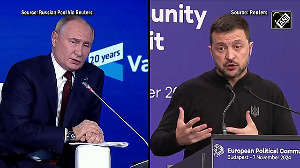The government-owned banks generally do a good job of what is mandated by their majority owner but most are failed business enterprises.
The 50th anniversary of bank nationalisation is an appropriate occasion for the owner to take a call on their future, says Tamal Bandyopadhyay.

Apart from Gandhi, only three people were involved in the bank nationalisation exercise -- P N Haksar, principal secretary of prime minister; A Bakshi, a deputy governor of the Reserve Bank of India (RBI); and a junior bureaucrat, D N Ghosh. The RBI governor was not kept in the loop.
Last Friday marked the 50th anniversary of bank nationalisation.
Fourteen banks with deposits of at least Rs 50 crore each were nationalised in the midnight of July 19, 1969, hours after Prime Minister Indira Gandhi addressed the nation on this.
The ordinance that paved the path for nationalisation was challenged, an interim stay was granted on a few issues but a 34-day trial before a 11-judge bench in Supreme Court later, all roadblocks were cleared.
This set of banks, along with State Bank of India (SBI) and its associate banks, had 85 per cent share in the deposits of the industry then.
A second round of nationalisation of six more commercial banks -- with deposits of more than Rs 200 crore each -- followed in 1980. At that time, the government-owned banks’ share in the industry was 91 per cent.
SBI, the nation’s largest lender, is majority government-owned but is not covered by the Act that nationalised 20 private banks for expanding the credit market.
Not too many bankers are in a mood for celebrations. Many analysts are questioning the results that nationalisation has yielded even as a few are advocating privatisation despite what a couple of large private banks had been through in recent times.
Before we walk down the intensive care unit where some of the public sector banks (PSBs) are resting these days, let’s take a look at the banking scenario in 1969.
Then, there were 73 commercial banks (excluding regional rural banks); now the figure is 91.
The number of bank branches have grown phenomenally -- from 8,262 to 1,41,756.
What is particularly important is the share of rural branches, which was just about 22 per cent in 1969 and has gone up to more than 35 per cent now -- from 1,832 to 50,081.
The share of semi-urban branches dropped from from 40 per cent to 27.5 per cent (3,223 to 9,063) while there has not been any significant change in the share of urban (1,447 to 25,498) and metropolitan branches (1,661 to 27,114).
The size of the banking industry has grown many times in the past five decades. Aggregate deposits have risen from a meagre Rs 4,646 crore to close to Rs 125 trillion and bank credit, from Rs 3,599 crore to Rs 96.5 trillion.
For the record, till the 1990s, the PSBs’ assets grew at a pace of around 4 per cent in sync with the average growth rate of the Indian economy.
That got changed dramatically in the first decade of this century (the credit growth was three times or more the growth of India’s GDP between 2006 and 2008) but the pace slowed considerably and many of them actually have been shrinking their balance sheets since 2015 after being forced to expose their weak underbelly -- a pile of bad assets.
Just a week before the promulgation of the ordinance to nationalise the banks, Gandhi, in her address at the Bangalore session of Indian National Congress on July 12, 1969, forcefully pitched for it.
Apart from Gandhi, only three people were involved in the exercise -- P N Haksar, principal secretary of prime minister; A Bakshi, a deputy governor of the Reserve Bank of India (RBI); and a junior bureaucrat, D N Ghosh. The RBI governor was not kept in the loop.
Indeed, there was politics behind bank nationalisation. But, there were other reasons too.
Many banks collapsed post World War II as they were financing speculative activities and the RBI, a relatively young banking regulator then, was finding it hard to supervise some 300 banks, most of which were into trade finance and reluctant to support industry and agriculture.
In 1960, when Palai Central Bank and Lakshmi Commercial Bank collapsed, pushed by finance minister Morarji Desai, the RBI brought down the number of banks from 328 in 1960 to 94 by 1965 through closures and mergers.
Post nationalisation, the government forced a merger only once -- that of New Bank of India with Punjab National Bank in 1993.
Now, the consolidation drive has been in full force. After ensuring merger of SBI’s associates with the parent, the government has merged two relatively small banks with Bank of Baroda and more such mergers could be on the cards.
Is consolidation the answer? Will it ensure efficiency? There are challenges in terms of duplication of branches, different technology platforms and, of course, issues related to HR.
Even if the industry successfully overcomes these hurdles, consolidation will not pare the share of the government-owned banks in the overall banking industry which is a little less than 70 per cent now -- much higher than most markets.
Who is to be blamed for the state of affairs in PSBs? The banks themselves and their majority owner -- the government.
After the first set of new private banks came into being in 1990s, for the first time, the government owned banks faced competition.
By allowing them to raise money from the public, the government tried to make them competitive and technology-savvy as they were answerable to their new owners.
That was a good move but two critical issues maimed them.
First, the project finance institutions were wound up and the PSBs, which did not know much beyond giving working capital loans, had no choice but to extend long-term financing to Indian corporations. That sowed the seeds of bad assets.
Second, the government ceded the majority ownership but not the control. It continues to appoint the chief executive officers (CEOs), plays a critical role in the constitution of the boards and uses the infrastructure of the industry at times for things remotely connected to banking.
It also does not pay the bankers market-related compensation. And, the bankers are being continuously scanned by investigative agencies. You can’t expect them to work wonders with both hands tied behind their back.
The Pradhan Mantri Jan Dhan Yojana, the world’s most expansive financial inclusion drive, has 36.06 crore new depositors.
The PSB’s contribution to this is 28.65 crore in contrast to private banks’ 1.25 crore (the rest is done by the regional rural banks). The government-owned banks generally do a good job of what is mandated by their majority owner but most are failed business enterprises.
The 50th anniversary of bank nationalisation is an appropriate occasion for the owner to take a call on their future.
Should they be continuously given capital for creating bad assets while lending to build infrastructure and doing the so-called nation building, or should some of them be allowed to fall by the wayside and even be privatised?
How long will they be allowed to live in nostalgia?
Is it time to celebrate or chant dirges?
Tamal Bandyopadhyay, a consulting editor of Business Standard, is an author and senior adviser to Jana Small Finance Bank Ltd. Twitter: @TamalBandyo.












 © 2025
© 2025